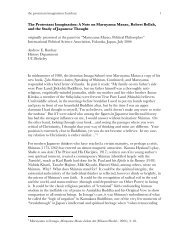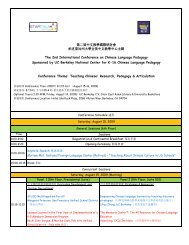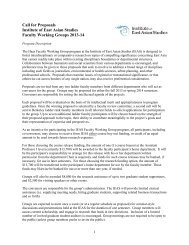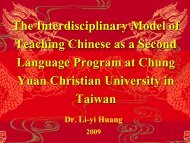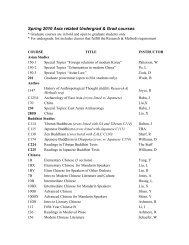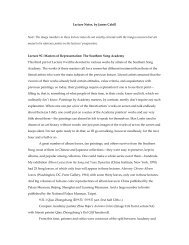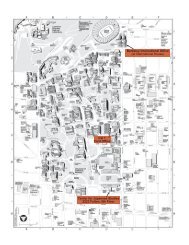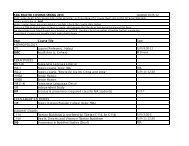Third Edition Spring 2013 - Institute of East Asian Studies, UC ...
Third Edition Spring 2013 - Institute of East Asian Studies, UC ...
Third Edition Spring 2013 - Institute of East Asian Studies, UC ...
You also want an ePaper? Increase the reach of your titles
YUMPU automatically turns print PDFs into web optimized ePapers that Google loves.
namese photographers, only those that shared the cultural wartimepurposes <strong>of</strong> the National Liberation Front were widely circulated.Constructed Cultural Memory during the WarThe communist cultural message is characterized by are-written past that reflected a heroic narrative and ultimately triumphantstruggle against foreign domination, while inscribing thefuture as a vision <strong>of</strong> communist utopia achieved through the inexorableworkings <strong>of</strong> History, Marxist style. 10 Images circulated typicallycaptured enthusiastic soldiers, crowds <strong>of</strong> joyous people (toconvey popular support), and moments <strong>of</strong> victory. These messagesare encapsulated in the subjects and circulations <strong>of</strong> what have nowbecome iconic photos taken by Vietnamese photographers. Themost widely circulated photo is that which captured the shootingdown <strong>of</strong> an American F-105D during a raid on Hanoi. Another famousphotograph is that <strong>of</strong> a young woman carrying a rifle whileescorting a captured American pilot. Another is <strong>of</strong> a group <strong>of</strong> youngsoldiers smiling and an image capturing Northern Vietnameseforces towering over enemy corpses to solidify an image victory.Constructed Cultural Memory <strong>of</strong> the War TodayToday the Vietnam War is portrayed in a different, but veryfamiliar way. Contrary to the graphically violent photographs thatin the United States narrate the history <strong>of</strong> the war as a moral andpolitical failure, images displayed in Vietnamese museums depictthe virtues, hopes, labors, and triumphs <strong>of</strong> the revolution to producea narrative <strong>of</strong> progressive and total victory. 11 Images typically10 Tai, Hue-Tam Ho. The Country <strong>of</strong> Memory: Remaking the past in Late SocialistVietnam. Berkeley: University <strong>of</strong> California, 2001.11 Schwenkel, Christina. Exhibiting War, Reconciling Pasts: Photographic Representationand Transnational Commemoration in Contemporary Vietnam. Journal <strong>of</strong>Vietnamese <strong>Studies</strong> 3.1, 2008.contain “themes <strong>of</strong> joy, play, enthusiasm and even love. Images inVietnamese museums regularly show acts <strong>of</strong> labor and preparationfor war, providing a visual testimony to Vietnam’s historical andheroic ‘spirit <strong>of</strong> resistance to foreign aggression in action.’ 12 Furthermore,Schwenkel emphasizes how these images re-inscribethe centrality <strong>of</strong> discourses <strong>of</strong> unity and solidarity to the war effort,as evident in photographs taken during or immediately after combatthat foreground action and victory rather than casualties. Evenwhen injured troops are present, the emphasis is on camaraderie(such as tending to their wounds) rather than on their pain andsuffering . 13Evidence <strong>of</strong> Constructed Cultural MemoryAs previously stated, American War photography served toconstruct a culture memory that starkly contrasts with that <strong>of</strong> theVietnamese. The memory is one <strong>of</strong> a moral and political failure. Famousphotographs that helped to sway American public opinionwere aimed at capturing the unnecessary suffering <strong>of</strong> the AmericanGI and the atrocities that occurred during the war. The Vietnamesegovernment has taken these famous photos from Western cultureand re-written their meanings to serve their interests. The Ministry<strong>of</strong> Culture takes this action because there are “political-ideologicalmotivations for utilizing photography ins<strong>of</strong>ar as the state regularlyinvokes memories <strong>of</strong> war through images to commemorate andkeep the spirit <strong>of</strong> the revolution alive, as well as to teach the youthabout the past, (so that) there is political interest in emphasizingvictorious achievements and collective acts <strong>of</strong> solidarity.” 14Gimblette’s process <strong>of</strong> cultural production and Schwenkel’snotes about the significance <strong>of</strong> utilizing photography as a politicaltool is exemplified by the book Vietnamese Photography in the20th Century. The book, released by Vietnam’s Ministry <strong>of</strong> Culture,features over 2,000 photos that are “closely linked to Vietnam12 Ibid1314 Ibid31 Mark Portillo Constructing “Culture” 32




